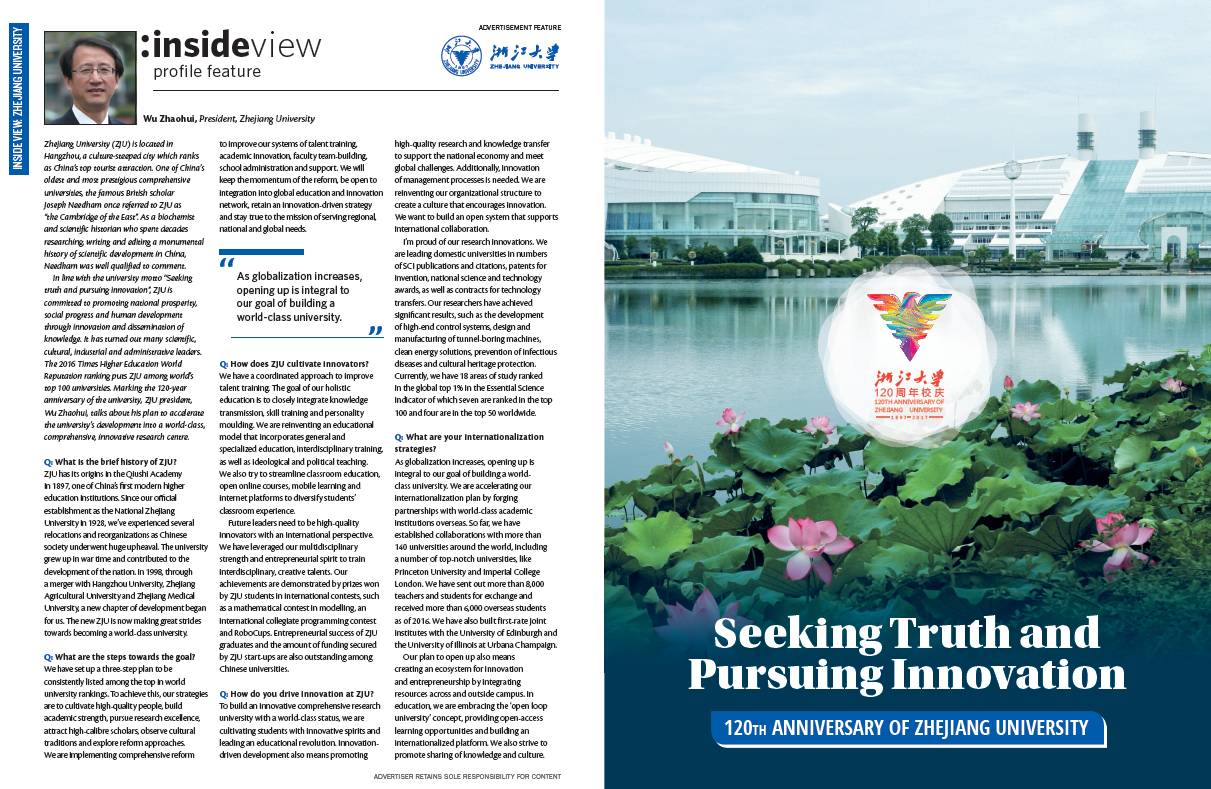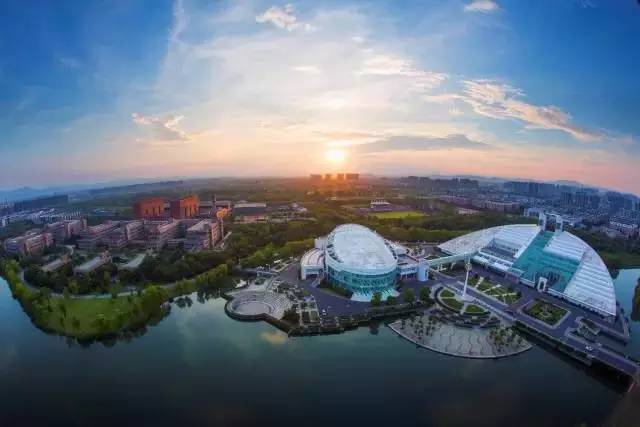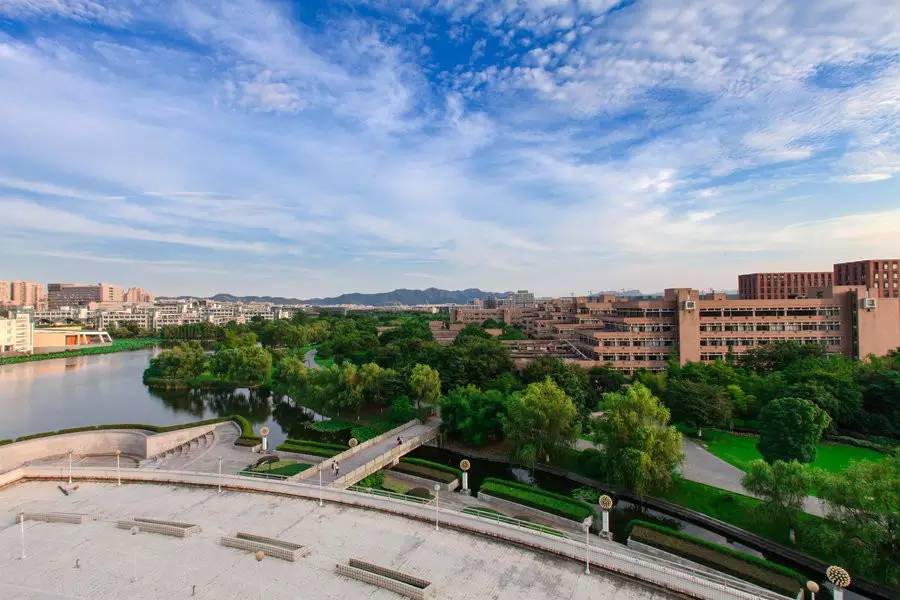吴朝晖校长通过Nature杂志介绍浙江大学:如何建设世界一流的创新型大学
吴朝晖校长通过Nature杂志介绍浙江大学:如何建设世界一流的创新型大学

新年的气息越来越浓,2017年伊始,我浙还有一个大新闻等你来围观~2017年1月19日出版的Nature中,吴朝晖校长以访谈形式向全世界Nature读者介绍浙江大学。据悉,Nature还将在随后的杂志中刊载浙江大学七大学部学术成果专题。

吴朝晖校长访谈
Nature杂志英文内容
Zhejiang University (ZJU) is located in Hangzhou, a culture-steeped city which ranks as China’s top tourist attraction. One of China’s oldest and most prestigious comprehensive universities, the famous British scholar Joseph Needham once referred to ZJU as “the Cambridge of the East”. As a biochemist and scientific historian who spent decades researching, writing and editing a monumental history of scientific development in China, Needham was well qualified to comment.
In line with the university motto “Seeking truth and pursuing innovation”, ZJU is committed to promoting national prosperity, social progress and human development through innovation and dissemination of knowledge. It has turned out many scientific, cultural, industrial and administrative leaders.The 2016 Times Higher Education World Reputation ranking puts ZJU among world’s top 100 universities. Marking the 120-year anniversary of the university, ZJU president, Wu Zhaohui, talks about his plan to accelerate the university’s development into a world-class, comprehensive, innovative research centre.
Q : What is the brief history of ZJU?
ZJU has its origins in the Qiushi Academy in 1897, one of China’s first modern higher education institutions. Since our official establishment as the National Zhejiang University in 1928, we’ve experienced several relocations and reorganizations as Chinese society underwent huge upheaval. The university grew up in war time and contributed to the development of the nation. In 1998, through a merger with Hangzhou University, Zhejiang Agricultural University and Zhejiang Medical University, a new chapter of development began for us. The new ZJU is now making great strides towards becoming a world-class university.
Q : What are the steps towards the goal?
We have set up a three-step plan to be consistently listed among the top in world university rankings. To achieve this, our strategies are to cultivate high-quality people, build academic strength, pursue research excellence, attract high-calibre scholars, observe cultural traditions and explore reform approaches. We are implementing comprehensive reform to improve our systems of talent training, academic innovation, faculty team-building, school administration and support. We will keep the momentum of the reform, be open to integration into global education and innovation network, retain an innovation-driven strategy and stay true to the mission of serving regional, national and global needs.
Q : How does ZJU cultivate innovators?
We have a coordinated approach to improve talent training. The goal of our holistic education is to closely integrate knowledge transmission, skill training and personality moulding. We are reinventing an educational model that incorporates general and specialized education, interdisciplinary training, as well as ideological and political teaching. We also try to streamline classroom education, open online courses, mobile learning and internet platforms to diversify students’ classroom experience.
Future leaders need to be high-quality innovators with an international perspective. We have leveraged our multidisciplinary strength and entrepreneurial spirit to train interdisciplinary, creative talents. Our achievements are demonstrated by prizes won by ZJU students in international contests, such as a mathematical contest in modelling, an international collegiate programming contest and RoboCups. Entrepreneurial success of ZJU graduates and the amount of funding secured by ZJU start-ups are also outstanding among Chinese universities.
Q : How do you drive innovation at ZJU?
To build an innovative comprehensive research university with a world-class status, we are cultivating students with innovative spirits and leading an educational revolution. Innovation-driven development also means promoting high-quality research and knowledge transfer to support the national economy and meet global challenges. Additionally, innovation of management processes is needed. We are reinventing our organizational structure to create a culture that encourages innovation. We want to build an open system that supports international collaboration.
I’m proud of our research innovations. We are leading domestic universities in numbers of SCI publications and citations, patents for invention, national science and technology awards, as well as contracts for technology transfers. Our researchers have achieved significant results, such as the development of high-end control systems, design and manufacturing of tunnel‑boring machines, clean energy solutions, prevention of infectious diseases and cultural heritage protection. Currently, we have 18 areas of study ranked in the global top 1% in the Essential Science Indicator of which seven are ranked in the top 100 and four are in the top 50 worldwide.
Q : What are your internationalization strategies?
As globalization increases, opening up is integral to our goal of building a world-class university. We are accelerating our internationalization plan by forging partnerships with world-class academic institutions overseas. So far, we have established collaborations with more than 140 universities around the world, including a number of top-notch universities, like Princeton University and Imperial College London. We have sent out more than 8,000 teachers and students for exchange and received more than 6,000 overseas students as of 2016. We have also built first-rate joint institutes with the University of Edinburgh and the University of Illinois at Urbana Champaign.
Our plan to open up also means creating an ecosystem for innovation and entrepreneurship by integrating resources across and outside campus. In education, we are embracing the ‘open loop university’ concept, providing open-access learning opportunities and building an internationalized platform. We also strive to promote sharing of knowledge and culture.

Nature杂志中文翻译
浙江大学坐落于中国历史文化名城、世界风景旅游胜地杭州,是中国历史最悠久、综合实力最强的大学之一,曾被英国著名学者李约瑟誉为“东方剑桥”。作为一名生物化学家和科学史学家,李约瑟一直致力于研究和编撰中国科学技术史,他的评价具有很强的说服力。
浙江大学秉持“求是创新”校训,致力于传播与创造知识,保护与传承文化,服务与引领社会,推动国家繁荣、社会进步和人类发展。学校培养了大批著名科学家、文化大师以及各行各业的精英翘楚。在《泰晤士报高等教育专刊》2016世界大学声誉排行榜中,浙江大学进入世界百强。值此120周年校庆之际,浙江大学校长吴朝晖就如何加快建设世界一流的综合型、研究型、创新型大学阐述了规划。

问 :您能否简要介绍浙江大学的历史沿革?
浙江大学的前身求是书院创办于1897年,是中国人自己创办最早的现代高等学校之一。学校于1928年更名为国立浙江大学,随后在抗战烽火中崛起,在国家建设中奉献,在并校融合中跨越,在争创一流中奋进。1998年,由原浙江大学、杭州大学、浙江农业大学、浙江医科大学合并组建新浙江大学,翻开了创建世界一流大学的新篇章。如今,浙江大学正朝着世界一流大学的建设目标大步迈进。
问 :浙江大学如何通过“三步走”实现建设世界一流大学的目标?
浙江大学确立了建设世界一流大学的“三步走”目标,即第一步到2020年,进入世界一流大学行列;第二步到2035年,稳居世界一流大学行列;第三步到2050年,位居世界一流大学前列。为顺利实现这个目标,学校制定了“六高强校”战略,即培育时代高才、构建学科高峰、打造科研高地、汇聚名师高人、积累文化高度、探索改革高招。同时学校通过实施综合改革,进一步构建完善“五大体系”,即人才培养体系、学术创新体系、人才队伍体系、学校治理体系、支撑保障体系。学校将坚持以改革为动力,以开放为特色,积极融入全球教育和创新网络,以创新为导向,全力服务国家战略、区域需求和全球挑战。
问 :浙江大学如何培养具有国际视野的高素质创新人才和未来领导者?
浙江大学计划通过整合培养、协同育人的方式构建完善一流人才培养体系。一是树立全人教育的培养目标,推进知识传授、能力培养、人格塑造的有机结合;二是创新全员育人的培养模式,推动通识教育、专业教育、交叉培养、思政教育的深度融合;三是构建全过程的教育生态圈,加强第一课堂、第二课堂、第三课堂和第四课堂的协同培养;四是打造全方位多元化的教学新体验,深化课堂教育、慕课教育、移动学习和网络平台的创新互动。
未来领导者必须是具有国际视野的高素质创新人才。浙江大学发挥了多学科多专业优势,强化复合型跨界创新人才培养。近年来,浙江大学的学生在国际大学生程序设计竞赛、数学建模竞赛、机器人世界杯足球赛等重大国际赛事上屡次夺得桂冠,浙大毕业生创业率、在校创业团队融资额等位居全国高校前茅。
问 :浙江大学如何建设世界一流的创新型大学?
为了将浙江大学建设成世界一流的“综合型、研究型、创新型”大学,我们坚持创新人才培养和引领高等教育改革创新。创新驱动发展需要推进高水平科研成果转化以服务支撑国家经济发展和服务全球挑战的重大需求。我们也正着力改革创新学校治理架构,营造激励创新的文化氛围,构建完善接轨世界、开放式的国际合作模式。
我为我们的研究创新感到自豪。在学术创新方面,浙江大学近年来发展态势强劲,SCI论文及引用、授权发明专利、获得国家科技奖励、技术输出合同规模等主要科研指标保持全国高校领先地位,在高端控制系统、盾构设计制造、能源清洁利用、传染病防治、文化遗产保护等领域取得了诸多具有重大影响的成果。目前,浙江大学有18个学科进入ESI排名前1%,其中,7个学科进入世界前100位,4个学科进入世界前50位。
问 :您如何描述浙江大学的国际化发展战略?
为应对全球化的未来挑战,浙江大学将致力于打造开放式、国际化的一流大学。学校正加快国际化战略布局,推进与世界顶尖大学和学术机构的合作交流。到目前为止,浙江大学已经与全球140多所高校建立了合作交流关系,包括一些顶尖的大学,如普林斯顿大学和伦敦帝国理工学院。2016年,师生出国出境交流达8000余人次,在校留学生超过6000名。学校积极推进与世界一流大学的战略合作,已经成立了浙大-爱丁堡大学联合学院、浙大-伊利诺伊大学香槟分校联合学院。
建设开放式的一流大学,我们就需要构建开放的创新生态系统,促进校内外的创新创业资源汇聚融合;推动开环的教育教学理念,创建开放式、国际化的学习机会和平台;建立开放共享的大学知识和文化源头。

◆◆◆
求是新闻
■
■
编辑:胡雨虹、徐媛
